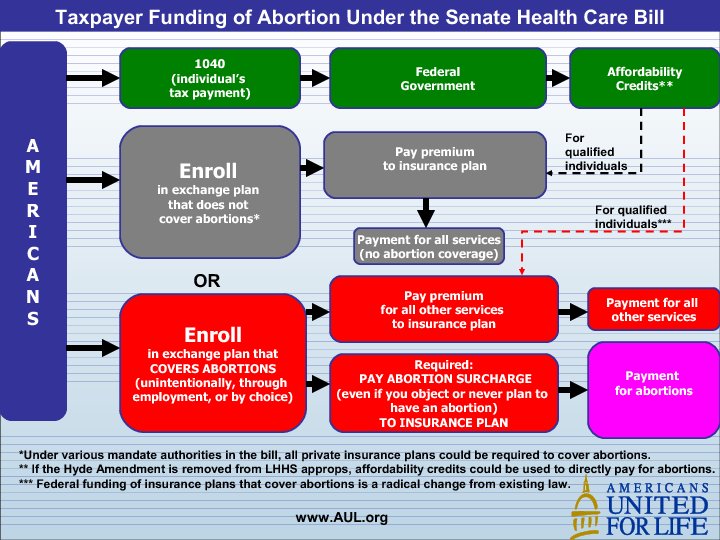This afternoon I received an email from Americans United for Life. "TAXPAYERS FORCED TO PAY FOR ABORTION UNDER PRESIDENT'S PLAN" it warned in a headline, which was followed by a "Statement of Dr. Charmaine Yoest":
This announcement marks the Presidents latest attempt to mislead the public on abortion. Last September, he promised taxpayers that no public funds would go to pay for abortion. He has since pushed strongly for the pro-abortion Senate health care bill, released his own health care proposal, and announced today's revised proposal—all three plans are a radical move to establish taxpayer-funded abortion. In the confusion of the health care debate, one thing is clear—the President is firmly committed to advancing taxpayer-funded abortion while continuing to claim otherwise.
I replied to the email with a curt request that the organization provide some evidence for Dr. Yoest's claims. I did not expect an answer. To his credit, a representative from Americans United for Life wrote me back, thanking me graciouslyfor my not-very-gracious note and forwarding several links to documents put together by the organization's legal team. Among these was the following chart:

The chart could not be clearer, and it accords well with what I know of the Senate Bill (which, as Americans United for Life tells us, is very close to the president's final proposal for reconciliation). Fortunately for the country, and unfortunately for Americans United for Life, the chart does not accord well with its own title: "Taxpayer Funding of Abortion Under the Senate Health Care Bill." Anyone who follows the arrows can see that no tax money is used to pay for abortions. Nor is anyone forced by the Senate Bill to enroll in a plan that covers abortion. Those who do enroll in such a plan will have to pay a separate premium that goes into a segregated fund for abortion payments. The chart calls this a "surcharge." That's not the term the Senate Bill uses, but never mind; it will do. According to the chart, enrollees would be required to pay the surcharge "even if [they] object or never plan to have an abortion." This is true, just as it's true that many who object to abortion and/or never plan to have an abortion (who does?) already pay for abortions through their health-insurance premiums. If people now want to avoid this, they can—but then, so could anyone under the system illustrated by the chart: see the big gray box that says, "Enroll in exchange plan that does not cover abortion."
But what about that asterisk? It sends us to the bottom of the chart, where we read that "under various mandate authorities in the bill, all private insurance plans could be required to cover abortions." That "could" is a tell. At this level of detail, the bold declarative rhetoric slips quietly into conditionals. In this case, though, the claim is not even conditionally correct: the Senate Bill would not allow insurance exchanges to offer only plans that cover abortion.
The double asterisks tell us that "if the Hyde Amendment is removed from LHHS approps, affordability credits could be used to directly pay for abortions," but there is no reason to suppose that the Hyde Amendment will be removed from LHHS appropriations, apart from the presumption that prochoice politicians are all necessarily sneaks and liars.
Finally, the triple asterisks inform us that "federal funding of insurance plans that cover abortions is a radical change from existing law." Notice the shift that has taken place between the top line of the chart, which announces taxpayer funding of abortion, and the last footnote, which more modestly predicts funding of insurance plans that cover abortions. The distinction is important. One reason the federal government has never before funded insurance plans that cover elective abortion is that it has never had to fund insurance for as many people as would receive affordability credits under the Senate Bill. You cannot just extend the Hyde Amendment to the new private-insurance exchanges without also translating it into a new legal structure. The Stupak Amendment does this rather nicely. But the nonnegotiable principle behind the Hyde Amendment is that the federal government should not be funding elective abortion. If the Senate can figure out a way to subsidize policies that cover abortion without actually paying for any abortions, then we should welcome its principled ingenuity and not carry on as if the Hyde Amendment were the first and last word in prolife policy. (People forget that the Hyde Amendment is itself a political compromise: it prevents the federal government from funding "elective"abortion while allowing it to fund abortions that many prolifers and the Catholic Church oppose.)
The lawyers at Americans United for Life also speculate that the Senate Bill's provision of more federal funding for community health clinics will mean funding for abortion. This is a legitimate concern. Prolife Democrats should try to fix the final legislation so that it explicitly prohibits the use of this funding for abortion. But here again we are in the realm of speculation. Groups like Americans United for Life scare us with claims about what the Democrats' health-insurance reform will do, and then, when asked for an explanation, fall back on hedged predictions about what it could do if this or that also happened --even when this and that seem quite unlikely. Such obviously unscrupulous rhetoric will probably not have much effect on the prolife Democrats in the House and Senate who may decide the fate of health-care reform (presumably they know what's actually in the bill). But whatever its immediate effect on them, the rhetoric has seriously undermined the credibility of people who are supposed to represent and inform prolife voters.
Please email comments to [email protected] and join the conversation on our Facebook page.
Share
Previous Story
Interview with Br. Guy Consolmagno
Next Story
Children's rights--quick!


